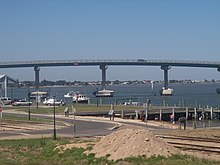Isla de Hindmarsh

La isla de Hindmarsh (en dialecto ngarrindjeri: Kumarangk) se encuentra en la desembocadura del río Murray, uno de los más grandes de Australia, que desemboca en el océano Índico. Está situada junto a la península de Fleurieu, cerca del pueblo de Goolwa, Australia Meridional. En 2001 se abrió un puente que ha convertido a la isla es un popular destino turístico.
En realidad, el río Murray, que discurre de norte a sur, desemboca en el lago Alexandrina, que está separado del mar por una serie de islas, la más grande las cuales es Hindmarsh. De ese modo, el agua que hay al norte de la isla es dulce, mientras, que al sur, junto a la barra de arena que separa el lago del mar, es salada. Al este de la isla se halla una de las bocas del río, la boca Murray, por donde el río sale al mar. Esta boca suele ir variando de lugar con el tiempo debido a las corrientes. Aquí se inicia el parque nacional Coorong (Coorong National Park), un ecosistema lacustre que se extiende 130 km hacia el sudeste de Hindmarsh.
Historia[editar]
El primer europeo en pisar la isla fue el capitán Charles Sturt en 1830. Otro capitán, John William Dundas Blenkinsop, le dio en 1837 el nombre del primer gobernador de Australia Meridional, sir John Hindmarsh. En la década de 1850 se construyó un molino de harina, en 1858 se estrenó un ferry entre Goolwa y la isla. Ese año se estrenó también el hilo telegráfico. En 1861 se construyó un cementerio y en 1900, una factoría quesera para explotar los quesos fabricados a partir de las vacas Hereford y las ovejas Shropshire que habían sido introducidas en Australia en 1868. La luz llegó a la isla en 1865.
Referencias[editar]
- Bell, Diane (ed.), Listen to Ngarrindjeri Women Speaking. Melbourne: Spinifex Press, 2008.
- Bell, Diane."The word of a woman: Ngarrindjeri stories and a bridge to Hindmarsh Island." In Peggy Brock (Ed.), Words and Silences: Aboriginal Women, politics and land (pp. 117-138). Sydney: Allen and Unwin, 2001.
- Bell, Diane. Ngarrindjerri Wurruwarrin: A world that is, was, and will be. Melbourne: Spinifex Press, 1998.
- Berndt, Ronald M. and Catherine H. Berndt with John Stanton. (1993). A World That Was: The Yaraldi of the Murray River and the Lakes, South Australia. Melbourne: Melbourne University Press at the Miegunyah Press.
- Fergie, Deane, "Secret envelopes and inferential tautologies". Journal of Australian Studies, 48, pp. 13-24, 1996.
- Hemming, Steven J., Inventing Ethnography. In Richard Nile and Lyndall Ryan (Eds.), "Secret Women's Business: The Hindmarsh Affair", Journal of Australian Studies, 48, pp. 25-39. St Lucia, UQP, 1996.
- Hemming, Steven J., "Not the slightest shred of evidence: A reply to Philip Clarke’s response to “Secret Women’s Business.”" Journal of Australian Studies, 5 (3) pp. 130-145, 1997
- Hemming, Stephen J. and Tom Trevorrow, "Kungun Ngarrindjeri Yunnan: archaeology, colonialism and re-claiming the future". In Claire Smith and H. Martin Wobst (Eds.) Indigenous Archaeologies: Decolonising Theory and Practice Routledge, pp. 243 – 261. New York: Routledge, 2005.
- Jenkin, Graham. Conquest of the Ngarrindjeri: The story of the lower Lakes Tribes. Adelaide: Rigby, 1979.
- Kartinyeri, Doreen. The Kartinyeri Family Genealogy. Volumes 1-2. Adelaide: South Australian Museum, 1989.
- Kartinyeri, Doreen. Ngarrindjeri Anzacs. Raukkan: South Australian Museum and Raukkan Council, 1996.
- Kartinyeri, Doreen. Ngarrindjeri Nation: Genealogies of Ngarrindjeri families. Adelaide: Wakefield Press, 2006.
- Mattingley, Christobel and Ken Hampton (Eds.), Survival in our own Land: Aboriginal experiences in South Australia since 1836, told by Nungas and others. Adelaide: Wakefield Press, 1988.
- Mead, Greg.A Royal Omission. South Australia: The Author, 1995.
- Muecke, Stephen and Adam Shoemaker. (Eds.). Legendary Tales of the Australian Aborigines, David Unaipon. Melbourne University Press at the Miegunyah Press, 2001
- Saunders, Cheryl. "Report to the Minister for Aboriginal and Torres Strait Islander Affairs on the significant Aboriginal area in the vicinity of Goolwa and Hindmarsh (Kumarangk) Island". Adelaide: South Australian Government Printer, 1994.
- Simons, Margaret.The Meeting of the Waters: The Hindmarsh Island Affair. Sydney: Hodder, 2003.
- Smith, W. Ramsay. Myths and Legends of the Australian Aboriginals. London: Harrap, 1930.
- Stevens, Iris. Report of the Hindmarsh Island Bridge Royal Commission. Adelaide: South Australian Government Printer, 1995.
- Sturt, Charles. Two Expeditions into the Interior of Southern Australia. Two volumes. London: Smith, Elder and Co., 1833.
- Taplin, George. The Narrinyeri. Reprinted in J.D.Woods (Ed.), "The Native Tribes of South Australia" (pp. 1-156). Adelaide: E.S. Wigg & Son, 1873.
- Tindale, Norman B. Journal of Researches in the South East of South Australia, 1. Adelaide: Anthropology Archives. South Australian Museum, 1931-1934.
- Trevorrow, Tom, Christine Finnimore, Steven Hemming, George Trevorrow, Matt Rigney, Veronica Brodie and Ellen Trevorrow, They took our land and then our children. Meningie: Ngarrindjeri Lands and Progress Association, 2007.
- Unaipon, David. Legendary Tales of the Australian Aborigines. Ms copy (MLA 1929 Cyreel 1134). Sydney: Mitchell Library, 1924-1925.
